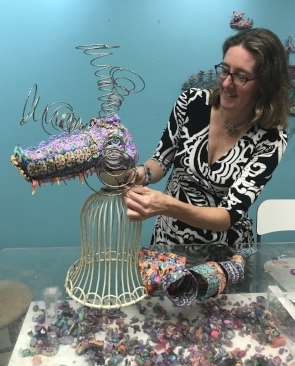The beginning of the Device Monster.
Earlier this year my friend Barbara Bridges invited me to be a part of her new nonprofit “Art to Change the World” and its fall event. She is what I call a social practice artist who has created art about such things as gluten and water pollution. I think the first thing I said to her was “well, I’m not a social practice artist,” but then she told me more about what she does and I got intrigued. The concept for the event was for each artist to choose an issue and then connect with an expert in the field, or someone living with the issue, to get more information and insight into the subject. Hmmm. This was definitely something new.
Before I knew it, I was head of the promotions committee and knee deep into volunteering for this exciting new group. Barbara was great at directing me to an issue that had connections for me. At first we called my idea “Device Addiction,” but when I talked to my 18-year-old daughter about it, she told me that the title was very off putting, seeming to blame the user. I had recently read an article about the way technology is designed to pull you in, making it difficult to let go, so I decided to call my issue “Persuasive Technology.”
It wasn’t long before I realized how easy it was to research my subject, because it popped up in conversation constantly. My friend, an art school teacher, told me she was worried kids were losing empathy because they weren’t learning how to interact when they were young. I also found it everywhere in the news. I read a book titled “Breaking up with Your Phone” by Catherine Price. I started to form the concept of creating a “Device Monster” sculpture that would embody how we feel when our technology is so integrated into our lives.
Then over the course of the summer I found two “topic voices” to talk to, offering a wider view of my topic. First I spoke with Mark Teresa, who is family therapist. He told me he was seeing the effects too. We talked about how much of what people experience today is behind a screen; it’s not hands-on or tactile. He lamented a loss of personal “alone time” because we always have our devices handy, with hundreds of people just a finger tap away. After speaking to him I got the idea to make my monster holding up a large screen in front.
Work in progress: adding kids climbing together on the sculpture.
I then met with my other topic voice, Angie Kalthoff, who is a K-12 technology integrationist. Her focus is meaningful technology integration, focusing on opportunities for technology creation, rather than consumption through devices. She told me about the many positive ways that technology can be used in the classroom and how she is working to create more projects and to teach teachers to use them. In younger grades they aren’t using screens to do programming, but as building blocks. It was very heartening to hear this positive view of the devices with which we are interacting daily. She also told me about Marina Umaschi Bers who’s given a TED Talk on how technology can either be a playpen, that traps a child with limited “toys,” or a playground, where a child can experiment and interact with other kids, learning through play. This was very exciting to me and became a major part of my piece.
As my sculpture evolved, I added many symbols for the way technology can be both negative and positive. I was at a meeting when I was nearly done, when I saw a friend’s phone light up with a text message, next to their arm. This gave me the idea to make my device’s arms covered with text messages. What better place to find actual messages then to ask my friends on FaceBook? So I crowdsourced a bunch of texts which I then transferred to the arms of my monster.
I also wanted an interactive piece, so I asked viewers to include their feelings about technology by writing a “good, bad, or ugly” statement onto a piece of paper, rolling it up and then adding it to the Device Monster’s tail. At the final exhibit, titled “See. Say. DO,” my monster got a bunch of tail spikes! I also learned even more about how technology impacts lives by talking to the viewers. One of my favorite moments was when I was showing my piece to some attendees and they talked about how teens sometimes sit around a table and text each other. At that moment a teen just happen to be listening in and they told us why this happens: sometimes teens are dealing with anxiety in social situations. Texting helps them get through it. This sparked an eye-opening conversation for all involved.
It was amazing to be part of this project and I could go on and on about the other surprising things that happened during the eleven-day event. The concept of working with a “topic expert” is something I would love to do again. Who knows? After this, I might just start to make more “social practice art.”
Even my parents were able to see the exhibit!


